
Sin City is an urban area (a city or part of) that caters to various vices.These vices may be legal (depending on area) or illegal activities which are tolerated. Examples of vices include sex-related services (prostitution, strip clubs, sex shops, etc.), gambling (casinos, betting shops, etc.), or drug use (alcohol, marijuana, etc. Consumption), and even excessive organized crime and gang. Las Vegas aka 'Sin City' is a destination full of lights, action and adult entertainment. But if you really want to know why Las Vegas is called Sin City, you'll have to go back a few years into Vegas's history, to a time even before mobsters and crime bosses controlled the action in Las Vegas. Ironically, just outside of Las Vegas is Boulder City, one of the only two cities in Nevada that prohibits gambling. Even though Las Vegas seems like a larger than life city, it's located in the Mojave Desert, the smallest desert in America. There's about one operating slot machine for every eight Las Vegas.
A still illegal activity in many parts of the world, gambling has been legal in the state of.

Who gave Las Vegas its nickname, anyways?
In Las Vegas, it's legal for adults to do many things that are outlawed in most major cities, such as gambling or buying an alcoholic beverage at 4 a.m. Adult entertainment venues, also known as gentleman's clubs or strip clubs, abound. Many Las Vegas destinations cater to adult vices, hence the enduring Sin City moniker.
Why is it called Sin City?
The original 'Sin City' designation dates back to 1906 and an area called Block 16, which was on First Street between Ogden and Stewart avenues, according to the Las Vegas Sun. This area and the nearby Block 17 were legally allowed to sell liquor, offering drinks to railroad travelers and workers. Block 16 saloons soon started renting out back rooms or upstairs areas to prostitutes, who would give the bar a cut of their earnings. One of the early saloons, The Arizona Club, also became a gambling hall in 1912. All of Sin City's vices were fully available more than 100 years ago, long before the era of mobsters with casino connections.
What it means today
While prostitution is legal in Nevada, it's technically not legal in Las Vegas. The city is trying to veer away from its sordid past, offering more family-oriented destinations and activities such as theme-park-style rides and museums. Even though Vegas has many more family-friendly venues than it used to, it's still a top destination for adults seeking a place that, compared to most towns, seems to cater to 'sins,' or vices, such as lust, drinking and gambling.
Drinks are available virtually any time day or night; some casinos even hand them out for free. Unlike many other metropolitan areas, it's legal to carry an open container from place to place outdoors and even drink it out in public, as long as the container is plastic and the drink is consumed well away from schools or places of worship.
Vehicle-based signs and hired help near the strip promote gentleman's clubs as if these are the top attraction in Las Vegas. No matter your reason for visiting Vegas, it's virtually impossible not to notice the 'Sin City' implications all around, which is probably why it's also a favorite destination for bachelor parties, business meetups and other temporary escapes from the rules of day-to-day society.
By Karlina ValeikoAs Las Vegas
How Vegas became Vegas

Sin City is an urban area (a city or part of) that caters to various vices.These vices may be legal (depending on area) or illegal activities which are tolerated. Examples of vices include sex-related services (prostitution, strip clubs, sex shops, etc.), gambling (casinos, betting shops, etc.), or drug use (alcohol, marijuana, etc. Consumption), and even excessive organized crime and gang. Las Vegas aka 'Sin City' is a destination full of lights, action and adult entertainment. But if you really want to know why Las Vegas is called Sin City, you'll have to go back a few years into Vegas's history, to a time even before mobsters and crime bosses controlled the action in Las Vegas. Ironically, just outside of Las Vegas is Boulder City, one of the only two cities in Nevada that prohibits gambling. Even though Las Vegas seems like a larger than life city, it's located in the Mojave Desert, the smallest desert in America. There's about one operating slot machine for every eight Las Vegas.
A still illegal activity in many parts of the world, gambling has been legal in the state of.
Who gave Las Vegas its nickname, anyways?
In Las Vegas, it's legal for adults to do many things that are outlawed in most major cities, such as gambling or buying an alcoholic beverage at 4 a.m. Adult entertainment venues, also known as gentleman's clubs or strip clubs, abound. Many Las Vegas destinations cater to adult vices, hence the enduring Sin City moniker.
Why is it called Sin City?
The original 'Sin City' designation dates back to 1906 and an area called Block 16, which was on First Street between Ogden and Stewart avenues, according to the Las Vegas Sun. This area and the nearby Block 17 were legally allowed to sell liquor, offering drinks to railroad travelers and workers. Block 16 saloons soon started renting out back rooms or upstairs areas to prostitutes, who would give the bar a cut of their earnings. One of the early saloons, The Arizona Club, also became a gambling hall in 1912. All of Sin City's vices were fully available more than 100 years ago, long before the era of mobsters with casino connections.
What it means today
While prostitution is legal in Nevada, it's technically not legal in Las Vegas. The city is trying to veer away from its sordid past, offering more family-oriented destinations and activities such as theme-park-style rides and museums. Even though Vegas has many more family-friendly venues than it used to, it's still a top destination for adults seeking a place that, compared to most towns, seems to cater to 'sins,' or vices, such as lust, drinking and gambling.
Drinks are available virtually any time day or night; some casinos even hand them out for free. Unlike many other metropolitan areas, it's legal to carry an open container from place to place outdoors and even drink it out in public, as long as the container is plastic and the drink is consumed well away from schools or places of worship.
Vehicle-based signs and hired help near the strip promote gentleman's clubs as if these are the top attraction in Las Vegas. No matter your reason for visiting Vegas, it's virtually impossible not to notice the 'Sin City' implications all around, which is probably why it's also a favorite destination for bachelor parties, business meetups and other temporary escapes from the rules of day-to-day society.
By Karlina Valeiko of Love Exploring |
